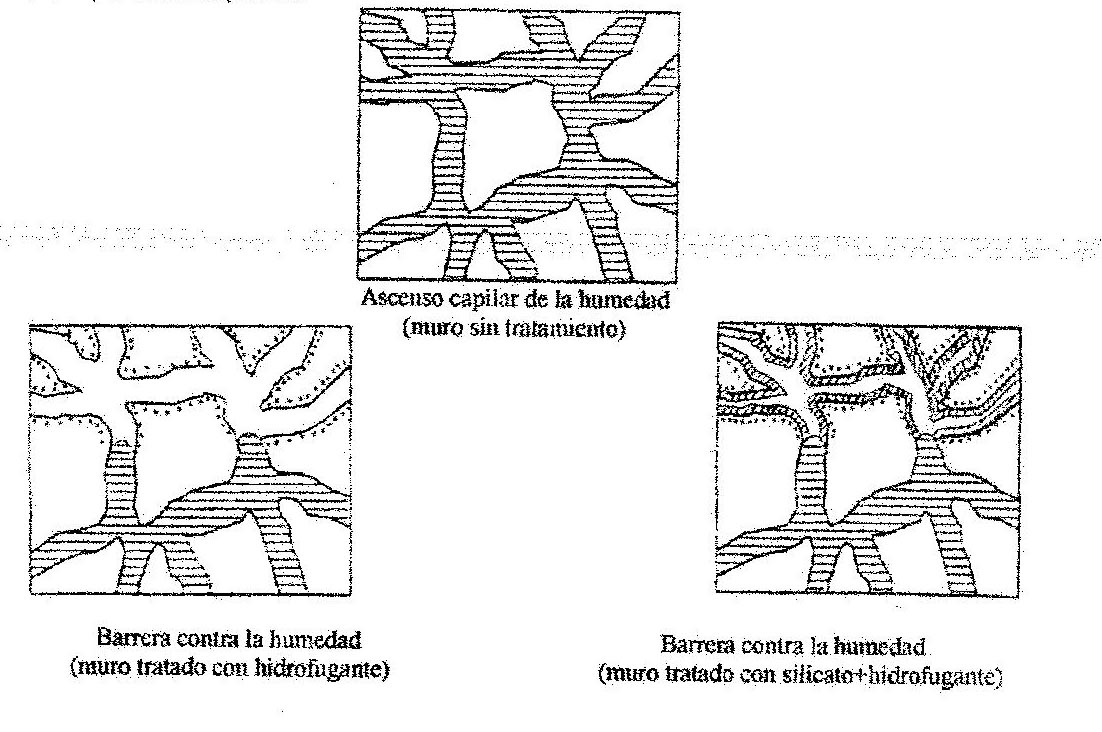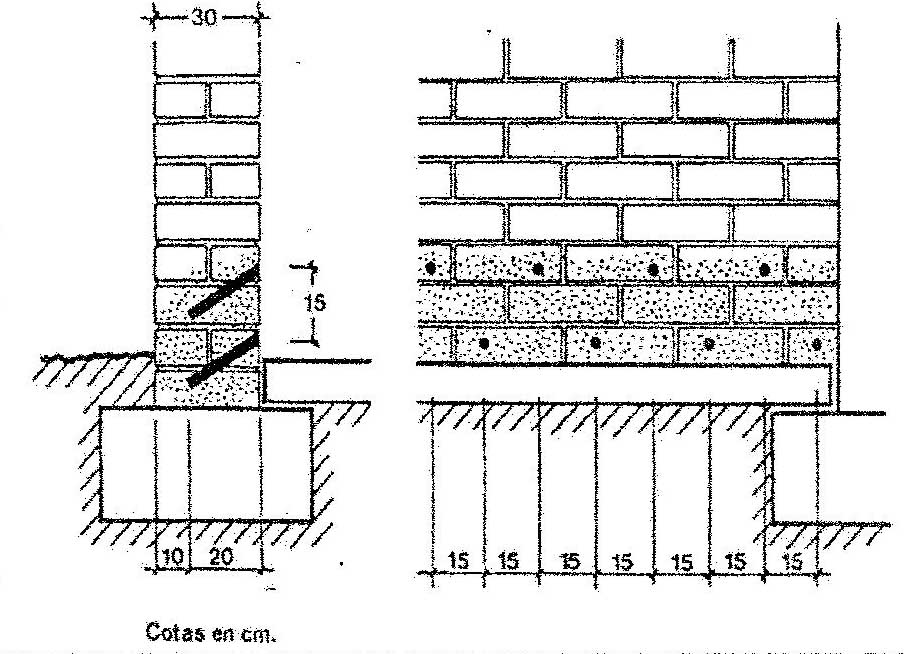Solve dampness by capillarity
This problem is very common in very old buildings that lack adequate foundations, as well as in cellars or in basements of homes with handcrafted constructions.
Sometimes, these dampnesses tend to be camouflaged using mortars.
However, despite the fact that aesthetically everything seems to be fine, the humidity will increase inside the wall and will deteriorate its structure to the point of collapsing and giving way.
The natural qualities of this product do not allow water to advance by capillarity towards the upper part of the walls. If you carry out an application by injection inside the areas where these types of problems exist, you will be able to stop the rise of the water and restore its consistency completely. In this way, and with a very simple job, you will repair the wall or facade.
WHAT ARE THE CAPILLARY rising damp?
The water in the ground rises from the basement walls or other structural elements causing moisture. Depending on the composition and the pores that the element present, the water will rise more or less easily, causing moisture by capillarity.
Rising Damp appears on walls and walls that are not properly insulated, where they have damaged the membranes to prevent moisture, or where not properly installed insulation and waterproofing against moisture.
Virtually all buildings are surrounded by natural moisture attempting to access the building structure. Materials such as stone and brick have a porous structure so if there is a membrane moisture, these materials act like a sponge.

This moisture is composed not only water but carries mineral salts that are deposited on the surface of the wall when the water evaporates.
If you see stains on the base of the walls, most likely your home be affected by capillarity. The height that can reach Damp spots depends on factors like:
a) Room temperature evaporation stimulating
b) The accumulation of rainwater in the basement of his home
c) crystallization occurs within its wall
.
WHAT IF WE STAY Damp?
Moisture can affect your health. Our treatments eliminate moisture, improve the welfare of your family !.
The humidity by capillarity are not aesthetic and if a potential risk to the health of people living in the household as they can produce the decomposition of elements such as wooden beams or wooden floors, plus increased heating costs due to increased conductivity on the walls.
The salt on the walls and walls is one of the consequences of rising damp.
The appearance of salts on the walls may have different origins: own sales of building elements with which the houses are executed, or which tends to be more frequent, which occurs when rainwater or groundwater dissolves these salts and dragged along the porous network of walls affected by capillary action, forming a so-called efflorescence stains.
The deposition of these salts causes damage to the wall structure. As more deposition of these white spots crystallized salts and salt lines that cause chipping of the paint chipping resulting walls are formed.
The accumulated wall addition salts act as sponges, absorbing humidity and transporting it to the walls, further aggravating the damp.
One of the most discouraging setbacks that we find in our house is the moisture in the lower part of the walls. Rising Damp, repellent paint and eventually degrading the plaster finishes.
The water rises from the ground by the wall of our stay through porous materials. It manifests with paint stains, chips, even mortar detachment ...
.
DETECT CAPILLARY HUMIDITY PROBLEMS
The crucial step to remove moisture by capillary action is to make a correct diagnosis, analyzing the source of the moisture.
The most common effects of rising damp include:
- Presence of stains and efflorescence (saltpetre) in the lower part of the walls
- Degradation and peeling walls
- Deteriorating housing and possible damage to the building structure
- Increased humidity with consequent unsafe for occupants
- Bad smells
- Breathing problems
- Asthma
- Allergies
Paint chipping off the walls in your low back is one of the most significant features of the moisture by capillarity.
When your walls or walls suffering from this type of moisture is advisable to treat them with as swiftly as possible, since otherwise rising damp will continue to rise and exacerbating the damage.
It remains for us the task of giving the best treatment to the problem of rising damp by capillary action, but often the task is not so simple ...
do not worry, with our system, you can repair yourself the humidity of the walls and walls, no major work and very economically.
.
How do I resolve myself PROBLEMS CAPILLARY HUMIDITY?
CAPILLARY HUMIDITY TREATMENT
The system consists in carrying out drilling with a drill in the outer face of the wall, which will be injected in the mineralizer LIQUID.
Mineralizing liquid, it acts to polymerize and internal protection barrier, which prevents access of water by capillarity.
DESCRIPTION mineraliser
This mineralizing comprises a potassium silicate and a potassium methyl siliconate.
Both products react with atmospheric CO2 giving potassium carbonates.
Potassium silicate to react with atmospheric CO2, is deposited on the capillary wall a layer of silica narrow capillary diameter, offering greater difficulty of passing moisture.
Moreover, by reacting with potassium methyl siliconate form polimetilsilano atmospheric CO2 serving as avoiding rise repellent moisture that may penetrate into these capillaries.
.

IF YOU WANT TO BUY LIQUID mineralizer, CLICK HERE
HOW mineralizing APPLIES TO SOLVE PROBLEMS Damp?
DILUTION
Injection is applied in the form of supply (USE, NOT THIN)
For application by brush, roller or spray: 1/1 potential dilution with water and a subsequent rinsing to drag the superficial excesses and avoid depositions.
SURFACE PREPARATION
The surface should be clean, dry and free of dust, grease, salt and other contaminants.
PREPARING THE WALL
The walls must contain less than 50-70% moisture. Otherwise injections will not be effective. Therefore they must be performed in periods where the walls are drier.
Depending on the material of the wall, the hole locations will be different:
POROUS BRICK WALLS: Holes the brick itself can be made both, as in the joints.
NO POROUS BRICK WALLS: The holes must be made at the joints.
SANDSTONE WALLS OR POROUS: The holes are made in the same stone.
Piedro NONPOROUS WALLS: The holes will be made at the joints.
ACTION
1. Drill holes (see drawing)
Alternative hole diameter Ø = 1.6-1.8 cm in two separate rows together in practice is 15 cm.
The spacing between these holes can vary between 12 and 15 cm (about 6 openings per lineal meter).
The inclination of the holes must be made between 30 and 45
The depth of the holes should be 2/3 the wall thickness. For very thick walls (50 cm) holes must be made on both sides.

2. Clean the holes once made.
3. Fill several times with mineralizing, the times necessary for 24 hours. (20-40 liters per meter in the case of walls with 20% absorption) by gravity.
In the case of insert injection pressure, the device should work from 0.5 to 20 bar. (High pressure can make the mineralizer by the boards.
The filling can be completed using a funnel and a rubber tube with cannula or with the aid of a spray deprived of its spray nozzle.
Every hole is filled several times within a few hours, leaving imbibing liquid each time until you notice that the wall has been completely saturated.
In the case of porous walls or voids, such as a hollow brick wall, it is advisable to inject a fluid mortar to fill all the gaps, and then after a reasonable setting time, make up the filling of mineralizer saturation.
The treated area should form a barrier throughout the thickness of the wall as regular as possible and in a manner that constitutes a totally impenetrable to moisture from the lower levels obstacle.
4. Plugging the holes with conventional mortar and plastering again if necessary.
You can then repicarse deteriorated mortar or plaster, and deal with the mineralizing externally to create a hydrophobic layer.
.
Al made plaster, care must be taken that it does not form union with the land, since moisture amount again through the plaster.
In the case of stone walls should be considered the kind of stone used in its construction.
In the case of soft sandstone or limestone may proceed with the same method.
If the wall is constructed of very hard stones, it does not perforate sense since they are almost never permeable, in this case the real culprit is rising damp mortar joint between blocks.
Should therefore be made holes in the boards, possibly on both sides, making the largest possible number of holes to ensure total saturation of the wall.
With this system, in addition to being waterproof wall it increases its resistance.
.
IF YOU WANT TO BUY LIQUID mineralizer to inject WALLS WITH MOISTURE, CLICK HERE
.
GENERAL CONSIDERATIONS CAPILLARY HUMIDITY
Overall Rising Damp requires an amount of water in the subsoil to be provided and continue to progress, and all measures to prevent underground water are positive.
If possible undercurrents are observed is convenient deflect outward doing drainage ditches output.
Another good practice is to place a layer of coarse gravel beneath the foundations to create a barrier without capillaries.
Another practice is to build up a small hill to get the water they depart the building
An ancient practice is built on pillars, which can be waterproof and is used in single-family homes in Florida and was known in Asturias with famous granaries to store animal feed.



Comments (7)